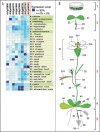Symplastic domains in the Arabidopsis shoot apical meristem correlate with PDLP1 expression patterns
- PMID: 19704520
- PMCID: PMC2634395
- DOI: 10.4161/psb.3.10.6020
Symplastic domains in the Arabidopsis shoot apical meristem correlate with PDLP1 expression patterns
Abstract
Symplastic domains in plants are defined by spatial limitations on cell-to-cell communication through plasmodesmata (Pds) and establish tissue boundaries necessary for metabolic and developmental programming. With the exception of the physical closure of Pds by callose, the cues and the processes for creating symplastic domains remain poorly understood. Recently, we identified a novel family of eight proteins, called Pd-located protein 1 (PDLP1). These proteins span the plasma membrane within Pds and likely form part of a signal transduction system that perceives external signals to regulate molecular trafficking between cells. For two members of this family that have high expression in the shoot apex we show that they have defined and partially overlapping tissue-specific expression patterns that correlate in part with previously defined symplastic domains. The importance of non-cell-autonomous proteins in shoot development and of the spatial rules that govern leaf and floral development highlight the need to have a clearer understanding of symplastic domains.
Keywords: Arabidopsis; functional redundancy; plasmodesmata; plasmodesmata-located protein 1; shoot apical meristem; symplastic domains.
Figures


Comment on
-
Specific targeting of a plasmodesmal protein affecting cell-to-cell communication.PLoS Biol. 2008 Jan;6(1):e7. doi: 10.1371/journal.pbio.0060007. PLoS Biol. 2008. PMID: 18215111 Free PMC article.
References
-
- Rinne PL, van der Schoot C. Symplasmic fields in the tunica of the shoot apical meristem coordinate morphogenetic events. Development. 1998;125:1477–1485. - PubMed
-
- Kim I, Zambryski PC. Cell-to-cell communication via plasmodesmata during Arabidopsis embryogenesis. Curr Opin Plant Biol. 2005;8:593–599. - PubMed
-
- Kim JY, Yuan Z, Jackson D. Developmental regulation and significance of KNOX protein trafficking in Arabidopsis. Development. 2003;130:4351–4362. - PubMed
LinkOut - more resources
Full Text Sources
Molecular Biology Databases
Research Materials
Miscellaneous
